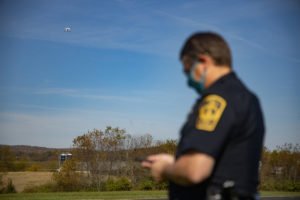Drone delivery and unmanned traffic management (UTM) company Wing has weighed in on the newly published rule on Remote ID for Drones. The Wing response to Remote ID says that the rule may have unintended consequences for American consumers, and leads to signficant privacy concerns.
While Wing expressed appreciation for the FAA’s efforts to accommodate recreational flyers in the new rule, the Wing response to Remote ID criticizes the decision to eliminate the Network option for compliance.
The use of broadcast Remote ID technology raises significant privacy concerns for American citizen, Wing says. “Unlike traditional aircraft flying between known airports, commercial drones fly closer to communities and between businesses and homes,” says the response. “While an observer tracking an airplane can’t infer much about the individuals or cargo onboard, an observer tracking a drone can infer sensitive information about specific users, including where they visit, spend time, and live and where customers receive packages from and when. American communities would not accept this type of surveillance of their deliveries or taxi trips on the road. They should not accept it in the sky.”
Network Remote ID technology would not raise the same concerns, Wing explains: “This method of RID leverages the internet — the most ubiquitous technological tool of our time — to share a drone’s location and identity information, like a license plate number, with anyone who has access to a cell phone or web browser,” says the response. “This allows a drone to be identified as it flies over without necessarily sharing that drone’s complete flight path or flight history, and that information, which can be more sensitive, is not displayed to the public and only available to law enforcement if they have proper credentials and a reason to need that information.”
In the published rule, the FAA wrote that the Network option had been removed from the final version in response to public comment and technical challenges.
“In response to the NPRM, the FAA received significant feedback about the network requirement identifying both public opposition to, and technical challenges with, implementing the network requirements,” says the text of the final rule. “The FAA had not foreseen or accounted for many of these challenges when it proposed using the network solution and USS framework. After careful consideration of these challenges, informed by public comment, the FAA decided to eliminate the requirement in this rulemaking to transmit remote identification messages through an Internet connection to a Remote ID USS.”
Following is the complete and unedited text of the Wing response to Remote ID.
Broadcast-Only Remote Identification of Drones May Have Unintended Consequences for American Consumers
Wing recognizes the hard work of the Department of Transportation and the Federal Aviation Administration (FAA) to complete rulemakings on unmanned aircraft remote identification and operations over people. For the United States to safely and responsibly realize the broad benefits and most helpful uses of unmanned aircraft, the FAA’s regulatory framework needs to continue to evolve.
Remote identification (RID) is a crucial technology that can provide the identity and location of a drone, validate transparent and safe operations for governments, law enforcement, community members and operators alike. With this rulemaking the FAA had an opportunity to lead the world by adopting performance-based, technology-neutral remote identification regulations that support safety, privacy, inclusivity, and the widespread use of drones in the United States.
Unfortunately, the final rule, unlike existing international standards, does not allow the use of equally effective network remote ID, and requires all UAS, no matter the use case, to use “broadcast” RID. This approach creates barriers to compliance and will have unintended negative privacy impacts for businesses and consumers. Unlike traditional aircraft flying between known airports, commercial drones fly closer to communities and between businesses and homes. While an observer tracking an airplane can’t infer much about the individuals or cargo onboard, an observer tracking a drone can infer sensitive information about specific users, including where they visit, spend time, and live and where customers receive packages from and when. American communities would not accept this type of surveillance of their deliveries or taxi trips on the road. They should not accept it in the sky.
Over the next 18 months, we urge the FAA to expand the pathways by which an operator can comply with the FAA’s remote ID requirements, enabling compliance through broadcast or network technologies.
The commercial drone industry has successfully demonstrated how “network” technologies meet the required RID elements of the FAA’s rule while protecting sensitive customer information. This method of RID leverages the internet — the most ubiquitous technological tool of our time — to share a drone’s location and identity information, like a license plate number, with anyone who has access to a cell phone or web browser. This allows a drone to be identified as it flies over without necessarily sharing that drone’s complete flight path or flight history, and that information, which can be more sensitive, is not displayed to the public and only available to law enforcement if they have proper credentials and a reason to need that information.
https://dronelife.com/2020/12/31/wing-response-to-remote-id-unintended-consequences-for-american-consumers/
 Unmanned Aerial Vehicle The latest drone news
Unmanned Aerial Vehicle The latest drone news




